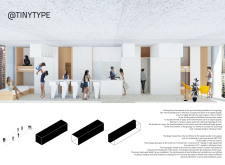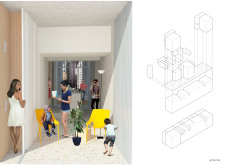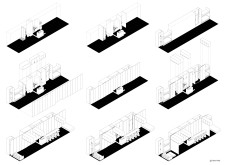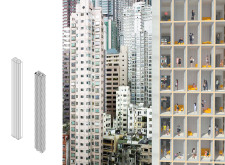5 key facts about this project
This architectural project represents a proactive response to its surroundings, demonstrating an awareness of the contemporary challenges faced in urban environments, including space constraints and the need for connectivity. The function of the building is multifaceted; it includes spaces for community interaction, individual reflection, and professional development, emphasizing its role as a nexus for diverse activities. By providing a flexible layout, the design allows users to adapt spaces according to their needs. This adaptability fosters engagement while encouraging collaboration and creativity among users.
The design approach is characterized by a minimalistic yet warm aesthetic. The facade employs a mix of materials that serve both aesthetic and functional purposes. Elements such as sustainably sourced timber, reinforced concrete, and large expanses of glass create a dialogue between the building and its environment. The timber elements offer a natural warmth that contrasts effectively with the sleekness of the glass, which provides ample natural light, reducing the reliance on artificial lighting. The concrete serves as a robust structural component, ensuring that the building remains grounded even in a busy urban setting.
Unique design elements are evident throughout the project. The use of expansive glass panels allows for panoramic views, connecting the interior spaces with the exterior environment and blurring the lines between inside and out. This intentional design choice fosters a sense of openness and encourages occupants to feel linked to the natural surroundings. Additionally, the building features green roofs and vertical gardens that not only enhance the visual appeal but also contribute to biodiversity and improve air quality in the urban setting.
The architectural plan integrates various communal spaces such as lounges, meeting rooms, and open terraces, promoting interaction and collaboration among users. These areas are thoughtfully placed to create a flow that guides individuals through the building while also encouraging casual encounters. The architecture prioritizes user experience by incorporating ergonomic design principles that cater to comfort and accessibility.
The project also employs innovative sustainable practices. The inclusion of energy-efficient systems, such as rainwater harvesting and solar panels, reflects a commitment to environmental responsibility. This approach reduces the building’s carbon footprint while promoting sustainability as an integral part of its operation and maintenance.
In summary, this architectural design project exemplifies a thoughtful response to contemporary urban challenges while promoting community interaction and environmental sustainability. Its careful consideration of materiality, user experience, and functionality distinguishes it within the architectural landscape. Readers are encouraged to explore the project in further detail, delving into the architectural plans, sections, and designs available to appreciate the full scope of this sophisticated architectural endeavor. By examining these elements, one can gain a deeper understanding of the innovative ideas that inform this project and its implications for future architectural practices.


























